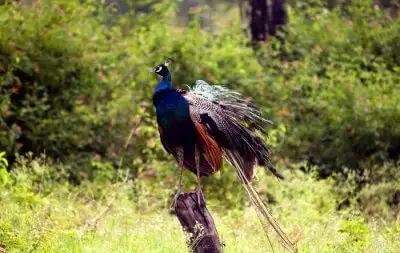Nestled amidst the Nilgiri Hills in Tamil Nadu, Mudumalai is a part of the greater Nilgiri Biosphere Reserve. It is one of the most important wildlife sanctuaries in South India. The name Mudumalai stands for the ancient hill range that descends down to the Mysore plateau and contiguous with Bandipur forest reserve, which gives it wider access to elephants and gaurs. The approach to the sanctuary from Ooty is spectacular, twisting, and turning down 36 hairpin bends through wooded hills and past waterfalls.
Mudumalai Wildlife Sanctuary is situated in the northwestern corner of Tamil Nadu at a distance of around 80 km from Coimbatore and 64 km from Udhagamandalam (also Ooty). It is also a part of the Nilgiri Biosphere reserve along with Bandipur National Park in Karnataka and Wynad Sanctuary in Kerala. The sanctuary extends from the latitude 11°32'-11°43' in the North to longitude 76°22'-76°45' in the East.
Despite its location in the Nilgiris, the climate of Mudumalai is different from the adjoining region. The summers (April to June) are hot while winters (December and January) are very cold. The western part of the sanctuary receives more rain than the eastern side during southwestern monsoon (June to September) while the eastern region receives more rain during the northwest monsoon (October to December). Overall, there is not much difference in the temperature. The park can be visited at most times of the year, but the best seasons are from March to June and September to October.
Tourists Attractions
Flora - Mudumalai has three types of forests, i.e., tropical moist deciduous, tropical dry deciduous, and southern tropical thorn. Mixed vegetation types are also present in addition to the tropical moist deciduous forests in regions where rainfall is higher.
Tropical dry deciduous forests are limited to the eastern side of the forest but merges into thorn forest where rainfall is low. Southern tropical thorn forest or scrub jungles are present in parts of Avarihalla, Moyar, and Bokkapuram blocks. Thorny and fleshy species, both of which are xerophytic adaptations, are characteristic of this vegetation type. Narrow belts of riverine vegetation occur along stream banks, notably the Moyar. There are teak plantations, particularly in Benne Block, and a eucalyptus plantation in the Masinagudi area.
Fauna - Wildlife in Mudumalai is very similar to other sanctuaries in Nilgiris, but is richer in avifauna. The predominant faunal species in this region are bonnet macaque and common langur. Tigers and leopards are also denizens of this place but they are a rare sight. Other important species are giant squirrels, flying squirrels, elephants, gaurs, sambar, chital, barking deer, mouse deer.
The avifaunal species in the sanctuary include racket-tailed drongo, black woodpecker, parakeets, barbets, mynas, cuckoos, Malabar trogon, Malabar gray hornbill, crested hawk eagle, and crested serpent eagle.



